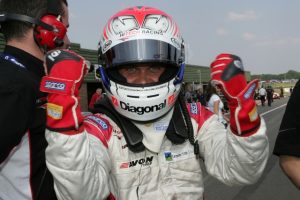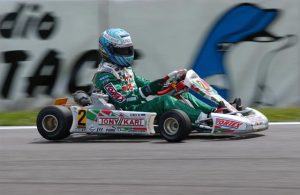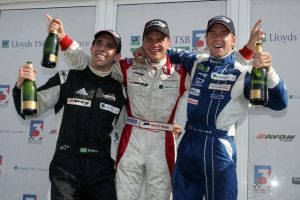
To summarise Estonia’s rapid rise in the world of motorsport: its most successful racing driver is older than the country itself.
Obviously Estonia has been inhabited for thousands of years, but 100 years ago it was mired in its War of Independence, which was followed by two occupations and membership of the Soviet Union until mid-1991. Marko Asmer, the country’s most successful single-seater export, was a seven-year-old at the time.
Motorsport existed in Estonia long before 1991, the country even had a car named after it, but the political and economic stability of the 21st century means the Baltic state is now hitting its golden period of talent. The latest generation is led by European Formula 3 drivers Ralf Aron and Juri Vips, who are both coached by 2007 British Formula 3 champion Asmer.
“I don’t just just driver-coach them, and that part is getting smaller all the time as they know how to drive. I don’t know what to call myself. Manager, mentor, whatever. I’ve been dealing with most of the things in their single-seater careers,” Asmer asserts.
“Finding teams, thinking which is the best way to go etc. When they started in Formula 4, obviously the driver coaching bit was quite a lot. Now they’re very – you know – you always keep an eye. Have a good look at the data, ask questions and maybe I can help with improvements. It’s not really [coaching] anymore.”
Organising careers is not easy, meaning “two drivers is already quite enough” for Asmer. As for karters, he has no appetite to “babysit”, meaning he’s dependant on Estonia producing the talents capable of stepping up to single-seaters.

“The level of karting in Estonia has?always been quite similar. In the worst years we have maybe 80 drivers. Better years, 100-120. It?s been like that since the ?90s. In the ?80s it was lots more with the Soviet kart, as you could do it affordably.
“The national level, especially in the Juniors, is pretty good. Even if they don?t have so many drivers. Year after year there have been some good guys popping up in the European or World Championship scene. In that way, it?s quite healthy.”
Estonia only has one circuit, the auto24ring, meaning karting graduates have to start car racing careers abroad.
Asmer has never raced cars in Estonia, although may do soon for fun. He started his single-seater career in British Formula Ford in 2003, winning twice but only managing 11th in the standings. Second in the FFord Festival mostly made up for it.
In the days of the Soviet Union, Estonian racers used to compete in Formula Easter, which was only open to drivers and cars from the Eastern Bloc.
“I don?t know the numbers so well, but Formula Easter was big. I don?t know how many Estonia chassis they made, but it was quite a lot for Estonia. It was a big factory, and all the Eastern bloc raced with these cars, which weren’t bad. They copied a lot from Western cars, and F1 cars, just made them smaller. They were nice cars. Not bad, for that time especially.”
There was no TV coverage of FEaster, primarily because people didn’t own TVs, but the Soviet Union’s size meant it attracted grid sizes any championship would be envious of.

“It?was big. The races were very competitive, and you had 60 or 70 cars on the grid. They had to do heats. There was driver against driver, but there was also nation against nation. You had what they called the Soviet Union national team, which was four or five drivers that went against all these other teams.
“My dad used to be quite successful. I guess the most successful in his era, with him being a seven-time Soviet Union champion, six-time runner-up, and a couple of times in third. He had a long career with these, and he was in the national team for a long time.”
Toivo Asmer, father of Marko, had a surprisingly easy entry into motorsport. Voluntary Sports Societies (VSS) were a Soviet Union scheme that encouraged mass physical activity. Most of the VSS were governed by trade unions, which were expected to support members who wanted to enter sports. Asmer, who had a degree in mechanical engineering, chose motorsport. He started in motorcycling, before switching over to become one of the Eastern Bloc’s best drivers. He’s most famous though for being Estonia’s former Minister of Regional Affairs, and is now an award-winning country musician.
His racing career ended after the Soviet Union’s collapse, meaning he was able to drive a western Reynard chassis in FEaster.
“That was the first car not from Estonia in Estonia. I remembered that time quite well, and the track in Latvia: Bikernieki,” recounts Marko Asmer.
“I travelled with him sometimes, when I was four or five years old, and the sounds and all these cars [got me interested]. The Reynard was a?nice car. When he stopped I obviously asked for a kart, but I didn?t get it for another four or five years. I tarted racing when I was almost 11, so I was quite late. He didn?t want me [to race], and finally he let me have a go as a birthday present. I started liking it, and it went quite fast [from there]. The national level wasn?t as good as it is now, and there was no karting drivers from Estonia going outside, so I was the first one and we went to Finland. The first races were really hard.”
Estonian stars of the past?
Marko Asmer – 28th in 2008 GP2, 2007 British F3 champion, 4th in 2007 Macau GP, 6th in Bahrain Superprix, 7th in 2011 Pau GP, 7th in 2005 Masters of F3, 7th in 2004 European F3 Cup, 10th in 2007 Japanese F3, 2nd in 2003 FFord Festival
Kevin Korjus?– 6th in 2011 FV8 3.5, 7th in 2013 GP3, 2010 FR2.0 Eurocup champion, 5th in 2009 FR2.0 NEC, 13th in 2012 Macau GP, 2nd in 2008 FR2.0 Finland, 3rd in 2008 FR2.0 NEZ -?4th in 2008 FR2.0 Estonia
Sten Pentus?– 4th in 2010 FV8 3.5, 4th in 2010 TRS – 2000 & ’01 Estonian F4 champion, 2000 FBaltic champion
Tonis Kasemets?– 19th in 2006 Champ Car, 18th in 2010 Indy Lights, 2nd in 2005 Atlantic, 4th in 2002 & ’03 US FF2000
Martin Rump?– 2015 FMasters China champion, 5th in 2014 TRS, 2nd in 2013 FR1.6 NEC and Sweden – 3rd in FR1.6 NEZ
Toomas Napa – 1987 Soviet F3 champion, 2nd in 1985 FEaster, 10th in 1990 Finnish F4 -?1990 Estonian F4 champion
Tonis Vanaselja?– 20th in 2008 Finnish F3, 2009 FR2.0 Austria champion, 7th in 2009 FR2.0 NEZ -?2015 Scandic (Estonia)
Tristan Viidas?– 3rd in 2013 French F4, 2nd in 2012 FBMW Talent Cup, 2011 FBMW Talent Cup Shootout winner
Jegor Popov?– 5th in 2007 Finnish F3, 11th in 2007 German F3 National Class -?2005 FBaltic champion, 5th in 2006 FBaltic
Raivo Tamm?– 7th in 2007 Finnish F3, 7th in 2010 Nordic F3 Masters, 8th in 2009 Remus F3 Cup -?2nd in 2005 & ’06 FBaltic
Karting was more affordable then than it is now, but private sponsorship was non-existent.
“It?s only the small individuals who make Estonia [look amazing]. We don?t have any support. There is obviously a union, but government support: none. Maybe once I had ?300 from the government for results, but not for [support]. That has never worked [in Estonia], and I don?t think it ever will.
“We didn?t have any wealthy families because the Soviet Union was collapsing and everybody had to start working up from zero the same way in the 90s. Now there are some wealthy families, as in kids can inherit something, and start to be like everyone else in Europe. In my case, when I was young my parents were suffering on the same level as everybody. Nobody had anything.
“If you look at the economic state and everything [human geography] and how little we are, and what we have to do, I guess it?s more work than some of you [British] guys have to do to get that far. We?have to overperform. It comes very hard, this kind of thing. But sometimes top drivers will come up. Our rally drivers of course too. They didn?t have any personal wealth, they worked hard to get opportunities.
“We haven?t had a driver in Formula 1, I?m sure it will happen one day. Estonia?s a very small nation, not rich. A very poor nation in the big picture. There?s no government or group support, it?s just individuals working very very hard, and we have to be proud to be having so many drivers very close to or racing in top series.”

Asmer made it to GP2, and was BMW Sauber’s test driver in 2008. A few years later Sten Pentus and Kevin Korjus made waves in Formula V8 3.5, with Korjus acting at Lotus’s reserve driver at the 2012 Italian Grand Prix. This is the closest Estonia has got to F1, but Aron and Vips may change that.
“Ralf [Aron] had a hard season last year, although it ended well in Macau [where he finished third],” explains Asmer.?“He started well this year, there?s been some issues and it?s not been all that straightforward for him, for different reasons.”
Aron is in his third year of F3. After winning the 2015 Italian Formula 4 title he graduated with Prema, and won in his fourth race. He switched to Hitech GP last year, then back to Prema for 2018, where Asmer believes he “feels more at home”. He may stay with the team for 2019, with Asmer expecting a move up to Formula 2.
“I got into karting when I was six. I was crazy about motorcycles but they were too dangerous, so my dad put me in a kart. Karted at a national level until I was 14, then I went to Europe for a couple of years,” Aron summarises.
“I never took motorsport seriously enough to want to be a professional in it, until 2015. In 2014 I wanted to go to a top karting team in Europe and fight for championships. But it was so expensive that we took a couple of offers from single-seater teams. Entry-level single-seater racing was the same price.
“So, as I was doing it for fun anyway I was like: fuck it, lets move to cars. It started going really well. At the end of my first year I got a test with Prema, thanks to Marko, which went really well as well. That?s why I drove with them in 2015. After that really was when it got serious.
Estonia’s 14-year-old hope
Ralf Aron’s younger brother Paul is the 2018 CIK-FIA European champion and WSK Champions Cup winner in the OK Junior karting class, and is already being touted as the next big thing.
“He’s done a really good job and made history in Estonia,” says Asmer.
“Back in the day, I won a world championship round in Formula Super A, which was the highest class. Next year he can [go up to OK].
“I’m really happy that my brother is doing well. When I started, my family and I didn’t know anything about the racing world and so on,” explains Ralf.
“With Paul we’ve been able to avoid the mistakes that we made with me. And it looks like it’s paying off.”
“Being back at Prema’s been better, bar Silverstone [where he scored one point]. I?ve been in the championship contention for the whole season, we?re doing a pretty good job. We had a bit of bad luck, like at Spa-Francorchamps we got crashed out of the lead [by Vips].”
As shown by Mick Schumacher’s path to the title, the 2018 season was unexpected if anything. There was greater expectation on Aron though as one of three third-year F3 drivers.
“My opinion is he should be winning all the time and in his opinion too,” says Asmer.?“But it?s so competitive, it?s not only Prema fighting for the title anymore. In Juri?s case I think it?s really good.”
ADAC F4 champion Vips drove for Motopark, and finished fourth in the standings with four wins. He may have been runner-up had Aron not controversially collided with him in the final race of the season.
“He was already really good at the beginning, but there were some rookie things in Pau: he just went too fast too early and crashed. He threw away a very good result there I?m sure, because he was very fast on those streets. Also Norisring, but that?s just part of the learning. And with him we didn?t get to do as much winter testing as we would?ve wanted. In that respect he has done a very good job.”

Vips’ introduction to motorsport came about by accident, but he was quicker to take it seriously than Aron was.
“My big brother did rental karting as a hobby, and he took me one time when I was six or seven,” he explains.
“I started going more and more, and it progressed from there. Competed in Estonia, then started in Europe when I was 13 as the Estonian competitions weren?t that competitive. I was lacking quite a lot of experience but I learned quite quickly, which is an aspect I still have now.
“This season’s gone above expectations. I didn’t think I was going to be that fast because I didn’t have any money for testing so at the beginning of the season I didn’t think I would be able to do the whole season. So I was lacking a lot of mileage in this car.?Other than that, I think it?s gone really well. I’m really up there in the championship, and I think there?s still more to come because I?ve thrown away quite a lot of points just through rookie errors. Being a rookie’s not much of an excuse because last year was a rookie champion. I could have been leading the championship for sure.”
As a young child, Vips used to follow Asmer’s career on TV and in print. He was a big fan at the time he was BMW’s test driver. When he first started testing single-seaters, Asmer approached his father declaring he wanted to work with his son. The partnership’s been successful, and Vips can now replicate Asmer’s fame having been signed to the Red Bull Junior Team.
Asmer plans to work with his proteges for as long as they want him to, and intends to remain friends with his students once they surpass their master. This won’t be new to Asmer, who driver coached Antonio Giovinazzi during his time in F3. The Italian’s testing role at Sauber has resulted in a full-time drive for 2019.
“Hopefully there?s another Estonian coming up at some point, and I can help them too. If needed. But I do it for a passion, it?s not really work for me. I just do it, for Estonia,” Asmer concludes.
